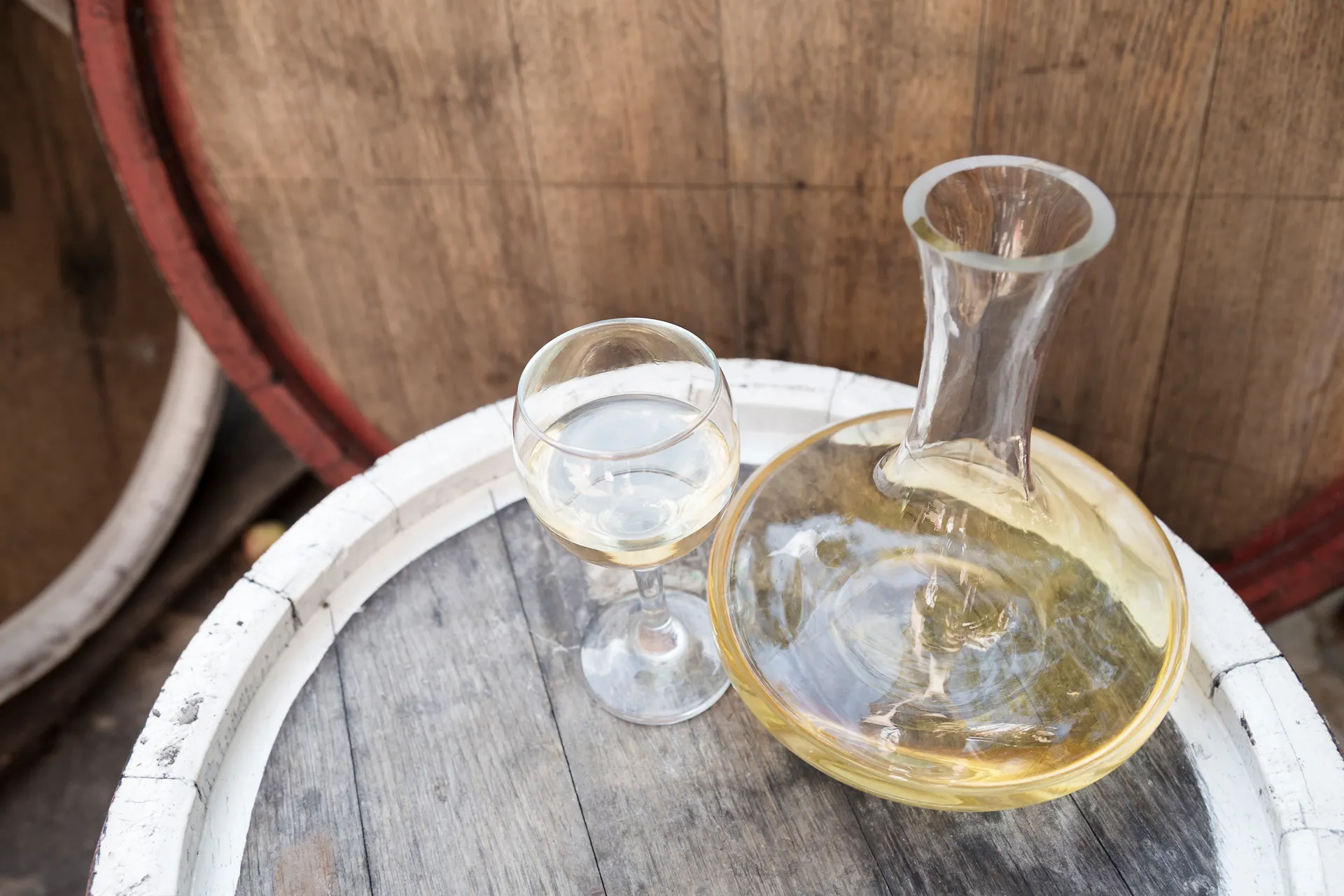For every high-end bar owner or sommelier, learning to decant wine is an essential skill. So if someone asks me:” Do you decant white wine?”, I will reply yes but I want to emphasize that understanding when to start decanting and which wines benefit from the process the most.
1. Decanting Wine?
Decanting wine is the process of delicately pouring it from one bottle into another while leaving the sediment at the bottom alone. It is usual practice to decant wine into a glass bottle with an easy-pour neck. Swans of various sizes (small, medium, and large), cornett, duck, and normal decanters are examples.
2. The Advantages of Decanting?

- Aeration from decanting improves flavor: The process of adding oxygen to a liquid is known as aeration. This process is known as letting the wine “breathe.” By relieving the tannins and releasing gases that have built up in the lack of oxygen, aeration improves the flavor of the wine. When wine is decanted, the flavors and aromas that are dormant in the bottle allow the space to expand and develop.
- Separating sediment from liquid: The primary goal of decanting is to separate the wine from the sediments that collect at the bottom of the bottle. Young white wines have the least sediment whereas older red wines, particularly vintage ports, have the most. Although it is not hazardous, sediment has a bad taste.
- In the event of a broken cork, how to keep the wine fresh: Occasionally, when a cork pops, unwanted solid particles may find their way into your wine glasses. Similar to how sediment gathers when liquid is decanted into another container, the cork will gather close to the bottle’s neck as you pour. By straining the alcohol during decanting, you can collect the smaller bits if the cork breaks.
3. Do you Decant White wine?

White wines typically don’t require decanting. Decanting can ruin white wines that are otherwise fine. White wine should only be decanted if it smells off, like burnt matches or eggs. A white wine or rosé can then be decanted for around 15 minutes.
White wine does not last as long as red wine since it has less tannin, yet many drinkers decant white wine to get a better sense of the flavors. The delicate aromas and flavors of white wine can be damaged by oxidation, and since this happens quickly, it is advisable to use as little aeration as possible.
White wine doesn’t drop much sediment if any at all, thus separation isn’t really necessary. Aerating a crisp, tight white wine for up to 30 minutes may be beneficial; taste it frequently to make sure you’re not drinking vinegar. Therefore, you can decant white wine with care and prudence. However, make sure to ask your guests first in case they’d like the bubbles.
4. Which Wines Need To Be Decanted?
Most types of wine can be decanted, including young, old, red, white, and even rosés. In actuality, almost all wines gain from decanting, even for a brief period, if only for the aeration. However, due to their stronger tannins, young, robust red wines in particular require decanting.
Decanting is only recommended for sparkling wines like Champagne. That’s because decanting and aeration limit the bounce that sparkling wines need to thrive, which is similar to how a soda loses its fizz when kept out of the refrigerator for too long.
You might also like:
- How long does red wine last once you open the screw top?
- Does Red Wine Get You Drunk Faster Than White Wine?
- Why Does Red Wine Make Your Poop Dark? The Ultimate Answer
5. Preparation for Decanting Wine
What you will need for wine decanting
- A crystal-clear, high-quality wine carafe
- Your preferred wine
- The candle or the flashlight
- Corkscrew
- Cutting tool
What serves as a decanter?
A crystal decanter is a container for holding liquid, especially alcoholic beverages like wine and whisky. You must get a decanter that meets your requirements because each decanter is made to a distinct design to aid a particular beverage.
You’ll hear me use the terms “decanter” and “carafe” throughout this article. Comparatively to a decanter, a carafe is a decorative container to hold the liquid in and is used for beverages other than wine, such as water or soft drinks.
Storing wines
More than most people realize, the temperature at which wine is stored matters. While severely cold air can increase the acidity of red wines that are heavy in tannic acid, cold temperatures delay the rate of fermentation.
The wine may ripen too quickly and lose its longevity in warm environments. Wine is also affected by temperature changes, so avoid storing it in a location with erratic temperatures as doing so might shorten the wine’s shelf life and speed up aging.
- As heat rises, stay away from high spots.
- To minimize disruptions, store in a cold, dark, empty location.
- Place champagne in the fridge.
- When kept in the refrigerator for an extended period, white wine, rosé, sparkling wine, and dessert wine lose flavor; but, when served chilled, the flavors are increased. The best approach is to chill them in the fridge for a few hours just before serving rather than keeping them there overnight.
- Wine should be kept horizontally with the corks wet. They swell as a result and the air and bacteria cannot enter the bottle.
- Allow room between bottles while storing them because vibrations cause the dead yeast cells in the sediment to flog about and cause a sour taste.
- Avoid direct sunlight or UV light because they will make wine taste flat or musty.
- A minimum of 74% humidity is required, although anything higher than 95% will promote mold
Wine storage temperature
- Red wines are stored at warmer temperatures than white wine, rosé, and sparkling wine.
- Wine can be kept for several months if it is kept at room temperature, which is 20 to 21 degrees Celsius (68 to 70F).
- Red wine is best when served at a temperature that is just below room temperature.
- White wine is delicious between 44 and 57 °F.
- At 38 °F to 45 °F, sparkling wine is at its best.
- Due to the increased ethanol evaporation, warm wine, usually above 70F, will start to smell more alcoholic.
Take your bottle of wine first, preferably from a dark, cool place where it isn’t usually disturbed or moved, wherever it has been kept. To allow the sediment to collect at the bottom of the bottle, you should stand the bottle upright for at least a few hours.
Make sure your carafe is spotless and clear of any debris or other items that can impair the aroma or flavor of your wine. Never use detergent or soap to clean your carafe; instead, use a mixture of crushed ice and coarse salt to get rid of any wine leftovers, and then just give it a hot water rinse. If this approach doesn’t convince you, you can run it through the dishwasher without any detergent or soap powder.
The next step is to rinse with mineral water to get rid of any smells it may have picked up. With a sharp knife, cut off the entire capsule from the neck of the bottle as you open it. To ensure there are no impediments when looking for sediment while decanting, remove any metal or plastic.
Because foils used to be made of lead in the past, it is customary to clip them from the bottom lip to prevent stray drips. However, foil cutters are made to cut the top of the lip. For occasions when the wine is on show, cutting the top lip is more aesthetically pleasing and desirable. It is best to place the bottle on the table for guests to use even when decanting.
Aim the corkscrew just off-center of the cork before removing it; this will center the radial diameter of the “worm” (the screw) and reduce the risk of it tearing or breaking the cork. One turn less than through the cork should be entered with the corkscrew. This should ensure that you do not break the cork.
6. How to Decant Wine
It takes a little touch and a little patience to decant wine. This is the procedure.

1. If your wine bottle has been stored horizontally, remove it from the storage space and allow it to stand upright for a full day before decanting. This enables the silt to collect at the bottle’s base.
2. To open your brand-new bottle of wine, use a corkscrew.
3. The neck of the bottle should be angled toward the decanter. Keep the angle of the bottle’s bottom below 45 degrees to prevent wine from flowing out (and disrupting the sediment).
4. Pour the wine into the decanter slowly. Search for any silt that is close to the aperture (light or candle can be useful for this).
5. Stop decanting if you observe any sediment approaching the bottleneck. Reverse the bottle’s tilt to its upright position, then begin.
6. Complete the wine pour, leaving about a half-ounce of sediment in the bottle.
Up to four hours before you intend to drink the wine, decant the bottle. Most wines can be over-decanted with little harm, but you should try to drink it or re-cork it within 18 hours.
7. How to serve a decanter of wine?
Keep the original bottle and cork (or screw top) even though your wine is now in a different container. Display the original bottle and cork alongside your crystal decanter if you’re serving the wine to visitors. While the cork serves as a stopper in case you need to pour the wine back into the bottle and store it for later, the label will let your guests know what they’re drinking.
8. How can you tell whether a wine has finished decanting?
Decanting is essential, for their wines to express themselves fully. Despite his recommendation to decant for at least 30 minutes, he warns that choosing the ideal moment to sip wine requires more skill than just setting a timer.
“You have to [experience] the wine’s evolution from the minute you open a bottle to enjoy the wine at its pinnacle after you have done so. You must comprehend where it began and where it ended. If you knew where and when he began his training as a child, and how arduous the road to the top was, you would respect his accomplishment much more and see it from a different perspective.
Decanting is more than just pouring wine into a decorative glass. It’s a strong weapon to have in your inventory that can significantly increase the benefits you derive from this live beverage. There are impacts and reactions we can recognize, but there isn’t always a clear-cut answer as to whether a specific bottle needs to be decanted.
You can just taste and consider whether there is anything else to be acquired from the experience.
9. How Long to Decant Wine?
The method of decanting you use will determine how long you should decant wine. When shock decanting, the majority of the advantages occur as soon as you pour the wine. For mature, aged red wine that has sediment on the bottom of the bottle, do not use it. The greatest wine aerators will do comparable tasks because shock decanting and aeration are extremely similar. Anyone interested in the distinctions between aeration and decanting should refer to this useful resource.
You may sip the wine, up to 15-20, have passed in the decanter. More time than that is not required. The recommended decanting time for older red wines when done traditionally ranges from 35 minutes to 4.5 hours.
Here is a list of the different types of wine. It conforms to the norm for most people. Instead of shock decanting, it is based on routine decanting. Nevertheless, feel free to adapt to the times! The most important thing is that you have a drink you enjoy; there is no set duration for decanting wine.
10. When to decant white wine?
The following four situations call for decanting wine:
- When drinking wine with sediment on the bottom, decant it to get the sediment out.
- Younger wines that need their tannic character mellowed should be decanted.
- White and rosé wines that have been diminished or their natural fragrance has been lost and flavor profile should be decanted (and this is rare).
- When a wine needs to be warmed from its storage temperature to its serving temperature (for more information, visit our wine storage guide)
11. FAQs
Q: Does white wine require aeration?
Wine can oxidize when exposed to air for a brief period. This procedure, called oxidation, aids in mellowing the flavors and releasing the scents. Most red and white wines will get better after at least 30 minutes of air exposure.
Q: Which wine types require decanting?
The consensus is that a wine has matured when it is 10 years or older. Decanting, however, is also beneficial for young red wines since the aeration makes them rounder and smoother and hastens the aging process. Younger wines (those under ten years old) should be decanted to enhance complexity by enhancing aromas and flavors.
Q: Does decanting work for all types of wines?
Decanting can be advantageous for almost all wines. They taste fruitier and smoother after the aeration procedure. Younger wines with very strong tannins benefit most from oxygen exposure. However, most sparkling wines shouldn’t be decanted.
Q: After decanting, is wine still drinkable?
If you close the decanter with an airtight seal, you can store it there. If you don’t, the flavor will be ruined by excessive aeration and oxidation. Only two to three days should be spent keeping it in the decanter. You can pour your wine into a fresh bottle and re-cork it if you don’t want to store it in a decanter.
Q: Does wine get stronger after being decanted?
Aeration from decanting improves flavor.
The process of adding oxygen to a liquid is known as aeration. This is frequently referred to as letting wine “breathe.” By relaxing the tannins and releasing gases that have built up in the lack of oxygen, aeration improves a wine’s flavor.
Q: What drawbacks are there to the decanting technique?
Disadvantages: Solids or liquids that dissolve in the combination cannot be separated. For instance, it cannot extract salt from water. Additionally, since they are too light and don’t stay at the bottom for very long, light solid contaminants like chalk powder cannot be separated from water using this method.
Q: Will decanting lessen the acidity?
Decanting can help a young red wine taste a little smoother, but the changes will only be minimal because, as was already noted, the method will not soften the tannins or lower the acidity. However, allowing the wine to “breathe” may encourage the release of extra scents.
Q: How is decanting used by chefs?
Pouring a liquid from one container into another to aerate it, separate any undesired sediment so that it stays in the first container, and enhance flavors by allowing the wine to soften or by lowering the temperature of the wine.
Q: Can wine be decanted into a glass?
You can generally perform a quick-and-dirty decant by pouring a regular wine into a glass, giving it a few swirls, and allowing the wine to air. This is possible since wine glasses are made to aerate wine. Depending on the wine, you should decide how long to let it breathe.
Q: How long should wine in a decanter breathe?
Give the wine a vigorous swirl and let it sit in the glass for 20 minutes. Any tannic red wine can be opened after this amount of time. If you intend to have more than one glass, decant the wine and give it about two hours to air. The wine’s powerful tannic flavor will be mellowed by the extended aeration time.
12. Conclusion
Do you decant white wine? Surely through this article, you have learned from the experience of decanting white wine and got your answer. Before decanting, you need to carefully review the conditions of the wine to give the best experience and avoid spoiling the wine.

In 2014, Leo Colon began working with Big Cottonwood Winery. Over the years he has remained part of this prestigious winery’s team and is also a contributor to other notable wine publications. As an ardent advocate for knowledge, Leo continues his vinous education to this day.

